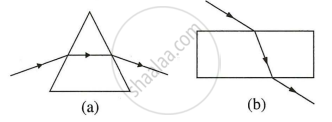Advertisements
Advertisements
Question
White light is dispersed by a prism. Inside the prism, compared to the blue light, the red light ______.
Options
slows down less and refracts more
slows down more and refracts less
slows down more and refracts more
slows down less and refracts less
Solution
White light is dispersed by a prism. Inside the prism, compared to the blue light, the red light slows down less and refracts less.
APPEARS IN
RELATED QUESTIONS
Define the term angle of deviation.
Write a relation for the angle of deviation (δ) for a ray of light passing through an equilateral prism in terms of the angle of incidence (i1) angle of emergence (i2) and angle of the prism (A).
Diagrams (a) and (b) in figure below show the refraction of a ray of light of single colour through a prism and a parallel sided glass slab respectively.

- In each diagram, label the incident, refracted, emergent rays and the angle of deviation.
- In what way the direction of emergent ray in the two cases differ with respect to the incident ray? Explain your answer.
A light ray of yellow colour is incident on an equilateral glass prism at an angel of incidence equal to 48° and suffers minimum deviation by an angle of 36°.
- What will be the angle of emergence?
- If the angle of incidence is changes to (a) 30°, (b) 60°, state whether the angle of deviation will be equal to, less than or more than 36°?
How does the angle of deviation depend on the refracting angle of the prism?
A ray of light is normally incident on one face of an equilateral glass prism. Answer the following:
What is the angle of incidence on the first face of the prism?
A ray of light is normally incident on one face of an equilateral glass prism. Answer the following:
Will the light ray suffer minimum deviation by the prism?
A ray of light suffers refraction through an equilateral prism. The deviation produced by the prism does not depend on the ______.
In an experiment to trace the path of a ray of light through a glass prism for different values of angle of incidence a student would find that the emergent ray:
The diagram below shows the path of a blue ray through the prism:
- Calculate the critical angle of the material of the prism for blue colour.
- What is the measure of the angle of this prism (A)?
- Which colour should replace the blue ray, for the ray to undergo Total Internal Reflection?

